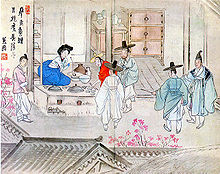- ↑ National Research Institute of Cultural Heritage (2013). "Jumak". Sul, Korean Alcoholic Beverages. 길잡이미디어. p. 140. ISBN 9788929901769 . Retrieved 27 February 2017.
- ↑ "History of Bars". life in Korea. Archived from the original on 2009-03-05. Retrieved 2009-02-22.
- ↑ 주막 (酒幕) (in Korean). EncyKorea . Retrieved 2020-10-10.
External links
| Jumak | |
 In Shin Yun-bok's genre painting titled Jusa geobae ("Holding a drinking party"), a jumak is depicted. |